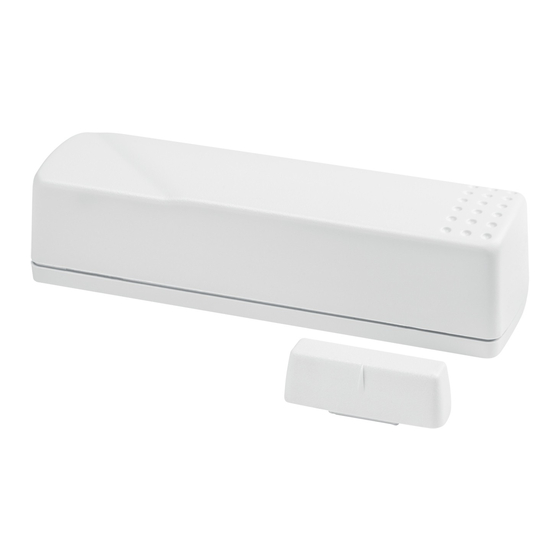
Advertisement
Quick Links
'
*( ,QWHUORJL[
Product Summary
The Learn Mode Shock Sensor has the following three main
functions:
•
To detect the vibrations made by an intruder trying to
break a window or door.
•
To detect a window or door opening.
•
To detect tamper situations, such as an intruder remov-
ing the sensor cover or the sensor from the wall.
Vibrations cause a momentary open circuit in the shock ele-
ment of the sensor. The circuit closes again when the vibra-
tion stops. The sensor microcontroller "sees" the open/close
action as a pulse, causing the sensor to transmit an alarm
signal. The sensor has two different detection modes:
•
Gross Attack - detect a violent blow sufficient in length to
trip sensor.
•
Pulse Count - detect a sufficient number of less violent
blows (rapping or tapping).
The sensor includes an internal magnetic reed switch that
must be disabled if it is not used.
Extend the battery life of the sensor by adding a second 3-
volt lithium battery.
Installation Guidelines
•
Learn the sensor before adjusting the shock sensitivity.
The sensor is shipped with the reed switch enabled and
open, and this is how it must be learned.
•
Before permanently mounting the sensor, test it at the
intended location to make sure that the panel can
receive sensor signal transmissions. The sensor is an
RF device and there may be blind or non-operational
locations within the installation. Normally, these can be
overcome by moving the sensor or receiver.
•
Always mount the shock sensor so that the detector is on
the frame and not on the glass. See Figure 2 for mount-
ing locations.
•
Mount the sensor in a location where the structure can
transmit vibrations to the sensor.
•
The sensor can be mounted on a vertical surface or on a
horizontal (flat) surface.
•
Make sure the window fits snugly in the frame and
doesn't move or rattle.
•
Hold the sensor against the frame to make sure the sen-
sor base fits on the surface area of the frame and doesn't
extend over the surface edges.
PRELIMINARY 10/1/03
1
/HDUQ 0RGH 6KRFN 6HQVRU
,QVWDOODWLRQ ,QVWUXFWLRQV
Vertical (Wall) Surface Mounting
Shock Sensor
Shock Sensor
Horizontal (Ledge) Surface Mounting
Shock Sensor
Figure 1. Mounting Options for Door/Window Sensor
Tools and Supplies
•
Control panel installation instructions
•
Phillips screwdriver
•
Slotted screwdriver (to pry off the cover)
•
Two #6 x 2 cm flathead screws for mounting the sensor
(included)
•
Two #6 x 1.5 cm screws for mounting the magnet
(included)
Document No. 466-2023 Rev. A
September 2003
Shock Sensor
Advertisement

Summary of Contents for GE Learn Mode Shock Sensor
- Page 1 /HDUQ 0RGH 6KRFN 6HQVRU *( ,QWHUORJL[ ,QVWDOODWLRQ ,QVWUXFWLRQV Document No. 466-2023 Rev. A PRELIMINARY 10/1/03 September 2003 Product Summary The Learn Mode Shock Sensor has the following three main Vertical (Wall) Surface Mounting functions: Shock Sensor Shock Sensor Shock Sensor •...
- Page 2 PRELIMINARY 10/1/03 Installation Note On a horizontal surface (sill or ledge), any orientation is Caution! allowed, but certain sensor element orientations are better You must be free of all static electricity when handling elec- than others. The element is much better at detecting hori- tronic components.
- Page 3 PRELIMINARY 10/1/03 Setting the Detection Mode To test the Gross Attack setting: • Apply high level shocks to the mounting structure, using The shock sensor has two detection modes: the LED as a guide to when the alarm trips (LED on for 4 •...
- Page 4 Dispose of used batteries according to the manufacturer’s instructions and/or local government authorities. Specifications Model No.: 60-975-95R and 60-975-11-95R RF Frequency: 319.5 MHz Compatibility: All GE Interlogix 319.5 MHz Control Panels and Receivers Battery Type: 3.0 VDC Lithium Recommended Battery: GE CR123A Typical Standby Current (µA): 10 Estimated Battery Life: 5 years (one battery);...



